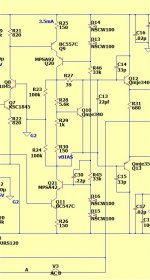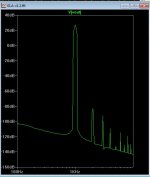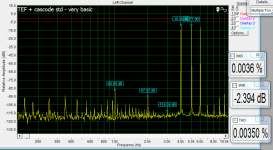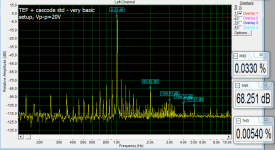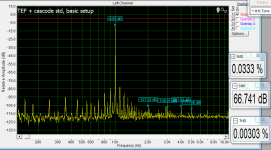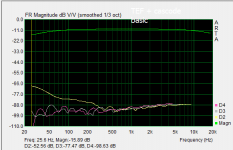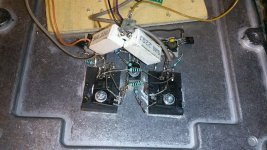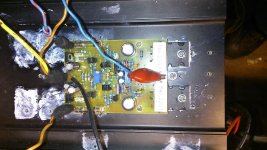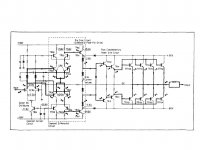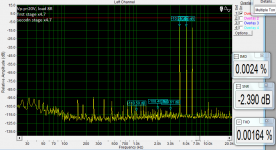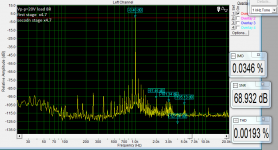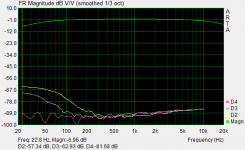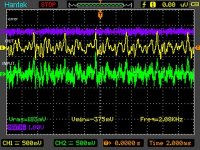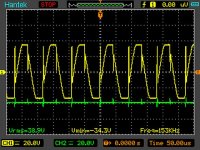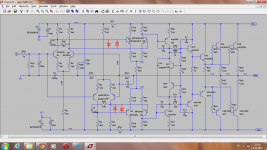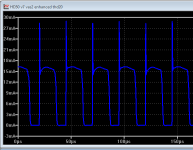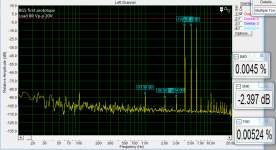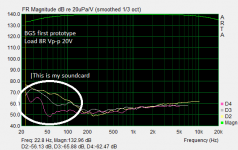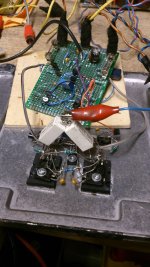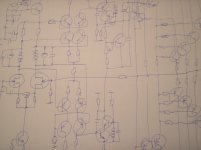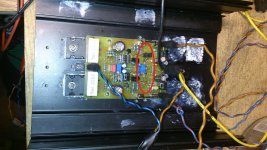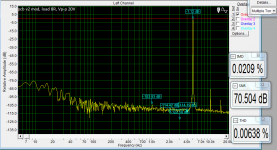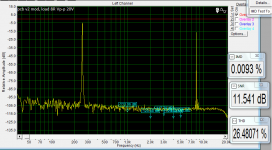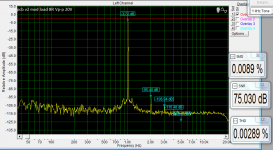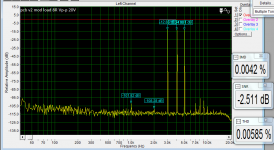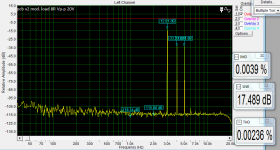Yes, this don't change anythig.
Except for 20 or more db PSRR 😀.
I played with both forms of this cascoded VAS.
The emitter to emitter version "likes" a ground reference. The direct rail to
rail version( like above - borys version) shows both lower THD and higher (better) PSRR
without a ground reference.
I've yet to refine this , but (at the expense of 12mm of extra PCB) , I
might add a cascode (below) to my GLA.
What I noticed was not the great reduction in distortion , but the
near elimination of BAD H5 and H7 harmonics at the output (with the cascode - below 2).
It will "sing" better ! 😀
OS
Attachments
Except for 20 or more db PSRR 😀.
Another advantage of push-pull VAS
Ost,
R27 is surprisingly big @ 39r.
Is that chosen to suit the lowish VAS current of 3.5mA?
I suspect that is so , it is what sansui uses.
After 32 years the bias is still 15mv across each .33R (no adjustment required 🙂).
Yes , apex ... A push-pull has definite advantages. As does a triple OP for "lowish"
(cool running-small device) VAS's 😉 .
OS
TEF + cascode is ready (I just have to adjust currents tomorrow), quick check If all is ok. The clipping is bit better with TEF at output. The first difference is more intermodulation products and higher increase thd with output power. Bellow my 1st measy prototype and standard board.
Attachments
Last edited:
I have spend a lot of time with this amp and can not sort out the last think, the clipping with sine wave - lack of my knowlage is not getting me to sort it out.
I have changed slightly the front stages degeneration resistors to get smoother harmonics spectrum (it should sound more warm).
On the last pic there is output (TEF version no cascoded vas) scalled down to input voltave level by pot divider, output amplitude is nearly 70V Vp-p. Sory for noise but my scope is not the best with low signals. But anyway as you can see the A-B channel (error) is a straight line!! Amp is performing really well.
NOW most important. Please help me to resolve the bad clipp on sin wave (square looks fine) at higher than 4kHz frequencies. This is really dead end for me.
With lower front stages gain it gets really a lot better but the rest of the parameters are a bit suffering. It does not matter what kind of output stage I am using the bad clipp is always there (TEF, darlington, cascoded or not all the same). Maybe some changes in feedback would help?
BIG THANKS
I have changed slightly the front stages degeneration resistors to get smoother harmonics spectrum (it should sound more warm).
On the last pic there is output (TEF version no cascoded vas) scalled down to input voltave level by pot divider, output amplitude is nearly 70V Vp-p. Sory for noise but my scope is not the best with low signals. But anyway as you can see the A-B channel (error) is a straight line!! Amp is performing really well.
NOW most important. Please help me to resolve the bad clipp on sin wave (square looks fine) at higher than 4kHz frequencies. This is really dead end for me.
With lower front stages gain it gets really a lot better but the rest of the parameters are a bit suffering. It does not matter what kind of output stage I am using the bad clipp is always there (TEF, darlington, cascoded or not all the same). Maybe some changes in feedback would help?
BIG THANKS
Attachments
Last edited:
Thanks apex.
I have an idea, i just have checked simulation on clipping and i
I have an idea, i just have checked simulation on clipping and i
Attachments
Last edited:
Thanks apex.
I have an idea, i just have checked simulation on clipping and i
Hi Borys I guess that's the VAS current you posted above, how does the output voltage look now.
Regards
hello
Some part of my post is missing heh. The problem is that vas and drivers collector currents are going to 0 mA at clipping conditions so tey can not turn on/off output transistor correctly. I might have solution for that. Thanks
Some part of my post is missing heh. The problem is that vas and drivers collector currents are going to 0 mA at clipping conditions so tey can not turn on/off output transistor correctly. I might have solution for that. Thanks
Bellow two files. One with psu at the front is my pcb v2, very good sonics, very good parameters but only bad clipping with sinus signal above 1kHz, however there is no clipping problems in symulation.
Second file is without sabilised psu at front, here are the clipping problems visible, I think that after finding solution in this symulation it can be applied on the actual amplifier.
BTW
I have measured the sound card itself with loop cable and gues what, the measurements are exacly the same as the amplifier measurements at 20 even 40Vp-p. It only means that parameters of the amp are a lot better than my sound card.
Second file is without sabilised psu at front, here are the clipping problems visible, I think that after finding solution in this symulation it can be applied on the actual amplifier.
BTW
I have measured the sound card itself with loop cable and gues what, the measurements are exacly the same as the amplifier measurements at 20 even 40Vp-p. It only means that parameters of the amp are a lot better than my sound card.
Attachments
Today first run of j-fet input version with single amp at the front of it.
There is no clipping problem for now. Not properly adjusted yet. Top end is very rich in detail and very precise so that is a good sign.
Config:
-j-fet input single amp
-bjt DD stage
-vas cascoded
-TEF stage at output
For now I am giving out with apex DD stage (maybe later on I will try to sort out my clipping issue).
There is no clipping problem for now. Not properly adjusted yet. Top end is very rich in detail and very precise so that is a good sign.
Config:
-j-fet input single amp
-bjt DD stage
-vas cascoded
-TEF stage at output
For now I am giving out with apex DD stage (maybe later on I will try to sort out my clipping issue).
Attachments
Last edited:
Today first run of j-fet input version with single amp at the front of it.
There is no clipping problem for now. Not properly adjusted yet. Top end is very rich in detail and very precise so that is a good sign.
Config:
-j-fet input single amp
-bjt DD stage
-vas cascoded
-TEF stage at output
For now I am giving out with apex DD stage (maybe later on I will try to sort out my clipping issue).
Nice work, I use 2SK117 with 6mA CCS (3mA per j-fet) and I prefer sound of single differential j-fet input stage.
I will use this topology for 'Lab Reference Amplifier'.
Regards
Attachments
Last edited:
My setup is very similar, I do not have cascoded DD stage, the Yamaha style sziklai/darligton VAS should be good to (like in AX14 amp), I was just wondering what would be better for vas, cascode or darligton .
I have so far 3,8mA for bot j-fets, would be recommeded to increase ccs for them ??
thx
I have so far 3,8mA for bot j-fets, would be recommeded to increase ccs for them ??
thx
My setup is very similar, I do not have cascoded DD stage, the Yamaha style sziklai/darligton VAS should be good to (like in AX14 amp), I was just wondering what would be better for vas, cascode or darligton .
I have so far 3,8mA for bot j-fets, would be recommeded to increase ccs for them ??
thx
VAS from HV23 is good http://www.diyaudio.com/forums/solid-state/162043-mosfet-amplifier-irfp240-irfp9240.html
3-7mA CCS for j-fets is ok.
Regards
VAS from HV23 is good http://www.diyaudio.com/forums/solid-state/162043-mosfet-amplifier-irfp240-irfp9240.html
3-7mA CCS for j-fets is ok.
Regards
Yes that kind of VAS I was about, will try it too.
I have upgraded slightly my previous board to single j-fet input.
Config:
-j-fet input (47R/2.2k) around 4mA total
-DD (150R/680R) 5mA
-vas cascode (standard not enhanced) 9mA
-darlington output 150mA
Mile if you can take a close look and tell me which area will need improvement please.
Maybe higher freq thd needs some ??
Config:
-j-fet input (47R/2.2k) around 4mA total
-DD (150R/680R) 5mA
-vas cascode (standard not enhanced) 9mA
-darlington output 150mA
Mile if you can take a close look and tell me which area will need improvement please.
Maybe higher freq thd needs some ??
Attachments
- Home
- Amplifiers
- Solid State
- Diamond Differential Amplifier
